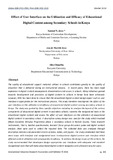Effect of User Interface on the Utilization and Efficacy of Educational Digital Content among Secondary Schools in Kenya
Abstract
The quality of educational support materials utilized in schools contributes greatly to the quality of education that is delivered during an instructional process. In recent years, there has been rapid expansion in digital content development, dissemination and access in schools. Many initiatives geared towards development and provisions of digital content to schools in Kenya have been witnessed. However, little has been done to ensure that the educational digital content design aspect such as user interface is appropriate for the instructional process. This study therefore investigated the effect of the user interface on the utilization and efficacy of educational digital content among secondary schools in Kenya. The study was guided by three specific objectives including to: analyze the layout of the various components of educational digital content in secondary schools; examine the navigational tools in the educational digital content and assess the effect of user interfaces on the utilization of educational digital content in secondary school. A descriptive survey design was used for the study which involved fifteen Economic Stimulus Programme phase 1 secondary schools in Nairobi County. Three research instruments, that is, teacher questionnaire, learners’ focus group discussion guide and digital content analysis sheet were used to collect the required data. The collected data was analyzed through descriptive statistics and presented in form of notes, tables, and figures. The study established that there were issues with interface and navigational tools in educational digital content user interface which affected content utilisation and consequently its efficacy. To address the design issues of the content, the study recommended that developers design appropriate user interfaces with adequate and standard navigational tools that will make educational digital content navigation and utilization easy for users.

